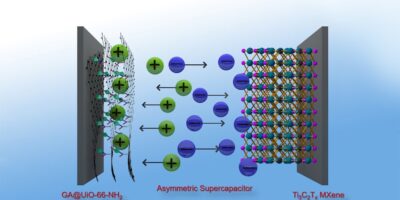Graphene hybrid material results in “highly efficient” supercapacitors
Researchers the Technical University Munich (TUM) believe they have created supercapacitors that challenge the supremacy of batteries. A team working with Roland Fischer, Professor of Inorganic and Metal-Organic Chemistry at the TUM, explain that it uses a sustainable graphene hybrid material as the basis of the energy storage device.
Usually, energy storage is associated with batteries and accumulators that provide energy for electronic devices but supercapacitors are increasingly used in laptops, cameras, mobile phones or vehicles. Unlike batteries they can quickly store large amounts of energy and output it quickly. For example, when a train brakes when entering the station, supercapacitors store the energy and provide it again at start up, when the train needs a lot of energy very quickly.
The conventional problem with capacitors is the lack of energy density. While lithium accumulators reach an energy density of up to 265kW hours (kW/h), supercapacitors have only been able to deliver 10 per cent of this.
Now, the TUM team believes it has developed a powerful, sustainable graphene hybrid material for supercapacitors. It serves as the positive electrode in the energy storage device. The researchers have combined it with a proven negative electrode based on titan and carbon.
The new energy storage device does not only attain an energy density of up to 73Wh/kg, which is roughly equivalent to the energy density of an nickel metal hydride (NiMH) battery, but also performs much better than most other supercapacitors at a power density of 16kW/kg.
Taking inspiration from nature, where hybrid materials optimise mechanical properties: Professor Fischer used the example of bones and teeth in the human body. “Their mechanical properties, such as hardness and elasticity are optimised through the combination of various materials,” he said. This principle was applied to suprercapacitors, where the team used the novel positive electrode of the storage unit with chemically modified graphene and combined it with a nano-structured metal organic framework (MOF).
“The high performance capabilities of the material is based on the combination of the microporous MOFs with the conductive graphene acid,” explains first author Jayaramulu Kolleboyina.
A large surface is important for good supercapacitors. It allows for the collection of a respectively large number of charge carriers within the material (this is the basic principle for the storage of electrical energy).
The researchers linked the graphene acid with the MOFs. The resulting hybrid MOFs have a very large inner surface of up to 900 square meters per gram and operate as positive electrodes in a supercapacitor.
For a chemically stable hybrid, strong chemical bonds are needed between the components. The researchers connected the graphene acid with a MOF-amino acid, which creates a type of peptide bond, explained Fischer.
The stable connection between the nano-structured components will increase the charging and discharging cycles without significant performance impairment, says the research team.
For comparison, a classic lithium accumulator has a useful life of around 5,000 cycles. The new cell retains close to 90 per cent capacity even after 10,000 cycles.




